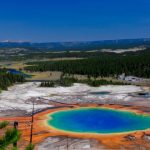
The United States: The No. 1 Travel Destination for 2026?
The travel industry is buzzing with news and speculation as a recent report points to the United States taking the crown as the #1 travel destination for 2026. While some have greeted this announcement with excitement and hope, others are taking a more measured approach, keen to explore the many tricky parts and tangled issues hidden within this news. In this opinion editorial, I aim to dig into the various aspects of this claim, analyze the underlying data and trends, and explore how both international and domestic visitors might have their perspectives changed as we take a closer look at the US travel landscape.
At first glance, the headline is undeniably exciting. Who wouldn’t want to explore a country as vast and diverse as the United States? From the bustling streets of New York City to the expansive national parks out west, the promise of adventure is all around. However, behind every headline there are several subtle details and complicated pieces that require careful attention. As we poke around this news, we must also consider the factors that contribute to the overall travel experience, including economic trends, infrastructure improvements, and even cultural nuances.
Diverse Attractions Across the US: Urban Wonders and Natural Splendors
One of the key selling points for the US as a travel destination is its staggering variety of attractions. Whether you crave the energy of metropolitan hubs or the calm of natural retreats, America offers something for every traveler. In my view, the true appeal lies in the balance between modern, bustling cities and picturesque landscapes that allow visitors to find their way through nature’s wonders.
Let’s break down some of the major features that shape the landscape of American travel:
- Iconic Cities – Urban centers such as Los Angeles, Chicago, and Miami provide vibrant cultural scenes, world-class museums, and dynamic nightlife.
- Natural Wonders – America’s national parks, including Yellowstone, the Grand Canyon, and Yosemite, offer breathtaking vistas and opportunities to connect with nature.
- Cultural Diversity – The United States is a melting pot of cultures and traditions, where culinary delights, art, and history blend to create a unique travel experience.
- Coastal Retreats – Beautiful beaches along both the Atlantic and Pacific coasts serve as a major draw for those looking to relax and unwind.
These components not only enhance the visitor experience but also cater to a wide range of interests, helping to create a balanced picture of what travel in America truly represents. It is this blend of urban excitement and natural tranquility that many believe sets the stage for the US to remain a top contender in the travel world for years to come.
Infrastructure Developments and Modern Conveniences
No discussion about travel experiences would be complete without addressing the state of infrastructure. Recent investments in transportation, accommodation, and digital connectivity have contributed significantly to enhancing the overall travel experience. Today’s visitors are not just looking for beautiful landscapes; they are in search of a seamless and convenient journey.
Over the past decade, improvements in airport facilities, high-speed rail links, and road networks have made it easier than ever for travelers to figure a path from one destination to another. These advancements help lessen the nerve-racking challenges of long-distance travel and ensure that each leg of the journey is both comfortable and enjoyable. In parallel, the hospitality industry has responded to rising expectations by offering a range of accommodations—from luxury hotels to cozy bed-and-breakfast inns—that cater to diverse preferences and budgets.
The digital revolution has played an essential role in this transformation. With robust Wi-Fi connectivity and the rise of mobile travel applications, visitors can manage their way through itineraries, get real-time travel updates, and even access personalized recommendations while on the move. Such technological enhancements make the travel experience not only more efficient but also more enriching as travelers can dive in and explore hidden gems along the way.
Economic Impacts and the Ripple Effect on Local Communities
The designation of the United States as a top travel destination is more than a mere title—it has significant implications for the local economies across the nation. Increased tourist numbers stimulate job creation, boost local businesses, and drive investment in infrastructure and services. However, these benefits do not come without their own set of challenges and subtle details that need to be managed carefully.
There are several critical economic factors affected by a rise in tourism:
- Job Creation – The travel sector is a major employer, and a boom in tourism often translates into more job opportunities in areas such as hospitality, transportation, and retail.
- Local Business Growth – Small businesses and local attractions tend to see a surge in patronage, which can lead to revitalization and growth in communities that might otherwise face economic stagnation.
- Infrastructure Investment – Increased tourist traffic often drives public and private investment in infrastructure, benefiting both visitors and long-time residents.
- Sustainability Concerns – While increased tourism can be a boon to local economies, it can also bring about environmental and social stresses if not managed with care.
It is essential that community leaders and policymakers work in tandem to tackle the confusing bits and overwhelming challenges that may arise from such a surge in travel. From implementing sustainable tourism practices to addressing the subtle parts of environmental conservation, a balanced approach is needed to ensure that the benefits of increased tourism are shared by everyone without leading to negative outcomes.
Exploring the Trends: What’s Driving the US Tourism Boom?
When trying to figure a path through the evolving travel trends, it becomes clear that multiple factors are coalescing to drive a potential tourism boom in the United States. A combination of favorable exchange rates, enhanced travel infrastructure, and a renewed focus on domestic travel post-pandemic contributes to a landscape ripe with opportunity.
To better understand these trends, let’s take a closer look at some of the driving forces behind the story:
- Post-Pandemic Recovery – As the global travel industry continues to recover, many travelers are revisiting their home countries or exploring nearby destinations. The United States, with its vast array of attractions, is an attractive option for domestic tourists looking to rediscover the joys of travel.
- Affordability and Accessibility – Favorable economic conditions in various regions have made travel more accessible and affordable. Special deals, government incentives, and competitive pricing in the hospitality sector have all contributed to a surge in bookings.
- Technological Integration – As travelers become more reliant on digital tools to plan and manage trips, innovations in travel technology, such as virtual tours and mobile guide apps, are making it easier to explore new destinations even before arriving on site.
Consider the following table, which summarizes some of these key trends with supporting data sourced from various tourism reports:
| Trend | Description | Impact on Tourism |
|---|---|---|
| Digital Transformation | Increased reliance on travel apps and online booking platforms | Streamlined planning and improved customer experiences |
| Economic Recovery | Post-pandemic economic recovery and favorable exchange rates | Boost in both domestic and international travel |
| Infrastructure Enhancement | Investment in transportation and hospitality sectors | More efficient travel and comfortable stays |
| Sustainable Tourism Initiatives | Local and national policies aimed at preserving natural sites | Long-term attractiveness as an eco-friendly destination |
This table is by no means exhaustive, but it does provide a snapshot of the dynamic forces at work and illustrates why many believe that the US is on the verge of a tourism renaissance.
Understanding the Marketing Appeal: Branding the US for a Global Audience
Effective marketing plays a super important role in shaping perceptions around travel destinations. When governments and the private sector work together to promote a country’s cultural and natural assets, the result is a powerful brand image that can attract millions of visitors. In the case of the United States, strategic marketing efforts have highlighted everything from iconic landmarks to hidden natural wonders, creating an inviting narrative for global audiences.
Let’s break down some of the essential strategies shaping this narrative:
- Emphasizing Unique Local Experiences – Instead of promoting one-size-fits-all travel packages, many campaigns focus on “experience-based” tourism, encouraging travelers to partake in local traditions, festivals, and culinary tours.
- Leveraging Social Media – Influencers, user-generated content, and interactive social media campaigns have become integral in painting a vibrant picture of travel in America. This grassroots approach often reveals subtle details and little twists about everyday life that can pique interest and inspire visits.
- Cultural Storytelling – American history and cultural diversity are richer than many realize. Marketers are tapping into this by weaving local histories and community stories into broader narratives that appeal to a global audience seeking authenticity and meaningful travel experiences.
By integrating these strategies, the US is positioning itself not just as a collection of destinations, but as a dynamic story waiting to be explored. The emphasis on both well-known and off-the-beaten-path experiences plays a key role in creating an emotionally resonant travel narrative that appeals to the modern adventurer.
Walking Through the Challenges: Managing Demand and Sustainability
While the prospect of a travel boom is undoubtedly fascinating, it is also full of problems that need careful management. With increased tourism, there is always the risk of environmental degradation, overcrowding, and cultural dilution. Balancing economic gain with preservation is one of the most intimidating challenges for any destination, and the United States is no exception.
Here are some of the main challenges that require smart solutions:
- Sustainability Measures – Initiatives to reduce carbon footprints, promote eco-friendly transportation, and support conservation efforts are being integrated into travel planning. How effective these measures can be will largely depend on the cooperation between federal, state, and local authorities.
- Overtourism – Popular sites risk becoming so crowded that the overall experience may be compromised for visitors and locals alike. Managing visitor flow through timed entry, reservation systems, and the promotion of alternative sites is one way to combat this issue.
- Community Impact – Local residents might feel overwhelmed or off-put by the rapid influx of tourists. Ensuring that travel promotion strategies include measures to preserve the local way of life is important for maintaining community support.
Addressing these issues requires a pragmatic and careful approach. Decision-makers need to work through the confusing bits and complicated pieces to craft policies that deliver sustainable growth while preserving the natural and cultural heritage that makes the US appealing in the first place.
Insights from Industry Experts and Data Analysts
Numerous industry experts and data analysts have tried to figure a path through the current travel trends. Their analyses suggest that while the US certainly has strong potential as a top destination, the underlying data is loaded with challenges and hidden complexities that must be navigated thoughtfully.
Several key insights emerge from expert discussions:
- Economic Indicators – Economic forecasts signal a rebound in disposable incomes and consumer confidence, which, in turn, contributes to higher travel spending. However, experts caution that even as travel becomes more affordable and accessible, the small distinctions between various market segments can lead to unexpected outcomes.
- Regional Competitiveness – While some regions within the United States are poised to benefit markedly from increased tourism, others may find themselves battling for attention. Urban centers might thrive, but rural areas must address the fine points of infrastructure and service delivery to ensure they are not left behind in the tourism race.
- Global Perception – The portrayal of American travel destinations through various media channels has a significant impact on global perceptions. Analysts highlight that how the US is represented in digital and traditional media can either enhance its appeal or inadvertently contribute to misinformation regarding safety, affordability, and quality of experiences.
A snapshot of some expert insights can be summarized in the following table:
| Area of Analysis | Expert Insights | Potential Impact |
|---|---|---|
| Economic Trends | Increased travel budgets post-pandemic and rising consumer confidence | Boost in travel spending and higher demand for quality services |
| Regional Disparities | Some regions may not be as equipped to handle tourist influx | Uneven growth; targeted investment needed in underdeveloped areas |
| Media Representation | Social media and influencer campaigns shape global opinions | Enhanced reputation or risk of oversaturation leads to mixed reviews |
While these figures and insights provide a promising outlook, they also remind us of the nerve-racking responsibilities that come with being a top travel destination. The balance between welcoming visitors and maintaining a high quality of life for all residents remains a challenging but critical piece of the overall puzzle.
Comparative Analysis: What Sets the US Apart?
In any debate about travel destinations, one inevitably wonders how the United States compares with other popular regions around the world. From the laid-back vibes of European cities to the rich historical tapestry of Asian destinations, what truly sets the US apart? In my opinion, it is the sheer scale and variety of experiences available that create a unique allure.
Below is a comparative analysis that highlights some of the key differences:
- Scalability and Diversity: Few countries offer the vastness and diversity of landscapes that the US does—from deserts and mountains to swamps and metropolitan hubs. This not only means a broader choice for visitors but also a variety of vacations that can cater to nerve-wracking adventurous days and restful retreats alike.
- Modern Infrastructure: Many European destinations, though culturally rich, might have older infrastructure that can present its own set of challenging twists and turns. The US has the advantage of modern developments and a focus on connectivity, making it easier for travelers to figure a path even in unfamiliar territories.
- Innovation in Travel Experiences: The United States has embraced digital innovations and sustainability initiatives at a pace that rivals even the most forward-thinking travel destinations. This leads to a travel environment where interactive apps, virtual pre-tours, and eco-conscious travel options are readily available.
In summary, while many regions provide memorable travel experiences, the unique combination of advanced infrastructure, diverse attractions, and a proactive approach to sustainable tourism gives the United States a competitive edge in the race for the top destination title.
Tips for Travelers: How to Maximize Your US Experience in 2026
Preparing for a journey to the United States in what is hailed to be a peak travel period requires not only an adventurous spirit but also smart planning and adaptability. With insights drawn from expert analyses, here are some practical suggestions to ensure that your visit is both enjoyable and hassle-free.
Planning Your Itinerary: Balancing Iconic Sites with Hidden Gems
When crafting your itinerary, it’s important to steer through both the well-known tourist attractions and the less-explored, off-the-beaten-path locales. Here are a few tips:
- Do Your Homework: Spend time poking around online for up-to-date information on attractions, local events, and transportation options. User reviews on travel forums and social media platforms can offer real-life insights that help you figure a path through your planning process.
- Mix Popular and Niche Destinations: While landmarks like the Statue of Liberty or the Grand Canyon are must-see, consider integrating local favorites to experience subtle parts of American life. Small towns often have hidden cultural and culinary treasures that can transform a routine trip into an extraordinary adventure.
- Utilize Technology: Leverage travel planning apps and digital maps to get real-time updates. Many applications let you schedule visits based on crowd levels and weather forecasts, ensuring that you make the most of your experience.
Staying Safe and Comfortable: Handling the Unexpected
No matter how well you plan, travel always comes with its share of nerve-wracking twists and turns. Here are some practical tips to manage the unpredictable bits:
- Local Emergency Services: Always be aware of local emergency numbers and nearby medical facilities. Carry a list of contacts and make sure your smartphone is equipped with offline maps.
- Travel Insurance: Consider robust travel insurance that covers both health emergencies and itinerary interruptions. While the idea of purchasing insurance might seem off-put, it can be a super important safety net when unexpected issues arise.
- Stay Flexible: Build flexibility into your trip. If weather or local events force a change in plans, having backup options can ease the stress of re-arranging your itinerary.
Embracing Local Culture: Engaging With Communities
A true travel experience goes beyond sightseeing. It’s about interacting with local communities, tasting regional cuisines, and experiencing day-to-day life. Here are ways to immerse yourself:
- Attend Local Festivals: Local festivals and community events provide an intimate look at local customs and traditions. They are a great way to meet residents and enjoy authentic cultural expressions.
- Support Local Businesses: From dining at locally owned restaurants to shopping at artisan markets, spending your money within the local community can make your trip more meaningful.
- Learn a Few Local Phrases: Even a modest effort to learn local greetings or expressions can go a long way in forging connections. This small twist may seem trivial, but it often opens doors to deeper interactions.
Looking Ahead: The Future of Travel in the United States
As the travel landscape continues to evolve, the United States appears poised on the brink of a new era of tourism. With rapid advances in technology, ongoing improvements to infrastructure, and a growing emphasis on sustainable practices, the stage is set for a travel renaissance that could redefine how visitors experience the country.
However, while the prospects are bright, there remain several subtle details and little twists that need addressing. Environmental concerns, community well-being, and equitable economic benefits must all be part of the discussion as we step forward. Only by working through these challenging bits with thoughtful planning and public-private cooperation can the promise of 2026 be fully realized.
Ongoing Policy Initiatives and Community Involvement
Recent government policies indicate a commitment to creating a sustainable tourism model. These include:
- Environmental Regulations: Efforts to limit environmental damage in popular tourist areas such as national parks are expanding, with new measures designed to preserve natural habitats while accommodating increasing visitor numbers.
- Community-Led Tourism Projects: Many local governments are partnering with residents to promote community tourism, ensuring that tourism development benefits local people and maintains cultural integrity.
- Technological Innovations: Investment in smart city technologies is making it easier to monitor tourist flows and manage resources, ultimately making travel safer and more convenient for everyone.
These initiatives are critical as they promise to address some of the overwhelming challenges posed by high tourist volumes. By integrating new technology and community input, the US can find its way through the tricky parts of managing such a vast and diverse tourism sector.
My Perspective on the US as a Top Travel Destination
From my vantage point as a travel enthusiast and editor, the proclamation of the United States as the number one travel destination for 2026 is a welcome development that invites both optimism and careful reflection. The US has always been a land of contrasts—a place where modernity meets nature, where bustling cities stand side by side with tranquil countrysides. This inherent diversity promises a rich and rewarding experience for visitors, provided that the challenges and hidden complexities are thoughtfully addressed.
I encourage prospective travelers to view this news as an opportunity to explore not just the well-trodden tourist paths but also the lesser-known roads that offer fresh insights into America’s cultural tapestry. It is precisely this blend of celebrated landmarks and undiscovered treasures that can transform a standard trip into an unforgettable adventure.
As travel trends continue to shift and new data comes to light, the United States will need to remain agile in its response to both opportunities and obstacles. Whether you are drawn by the promise of iconic landmarks, the lure of pristine natural parks, or the richness of a multicultural heritage, your travel journey through the US is bound to be a dynamic interplay of excitement and everyday surprises.
Final Thoughts: Embracing the Journey Ahead
In conclusion, the narrative of the United States as the top travel destination for 2026 is more than just a headline—it is a call to explore, adapt, and transform our understanding of travel in a rapidly changing world. As we take a closer look at the trends, analyze the economic impacts, and weigh the challenges against the opportunities, one thing remains clear: the US offers a multifaceted experience that is as inviting as it is complex.
Travelers looking to maximize their adventures should be ready to handle the nerve-racking twists and turns of planning while remaining open to spontaneous discoveries along the way. Whether through immersing oneself in local culture, leveraging modern technological conveniences, or simply enjoying the vast natural beauty that spans across 50 states, the journey promises to be an enriching experience.
The coming years will undoubtedly bring further changes and surprises in the travel arena. By staying informed, planning smartly, and appreciating the subtle details of every destination, visitors can ensure that their trips are both enjoyable and sustainable. As policymakers, businesses, and communities work together to address the challenges of increased tourism, there lies a genuine opportunity to create a model that can be celebrated worldwide.
Key Takeaways for the Modern Traveler
- Diverse Experiences: Embrace the blend of urban excitement and natural tranquility that characterizes the United States.
- Smart Planning: Invest time in planning your itinerary, including both must-see attractions and local hidden gems.
- Sustainable Choices: Support eco-friendly travel practices and local businesses to ensure that your journey benefits communities at every level.
- Stay Informed: Keep up with the latest travel advisories, technological tools, and community-led initiatives to make your adventure as smooth as possible.
Ultimately, whether you are a seasoned explorer or a first-time visitor, the evolving travel scene in the United States offers something super important for every kind of traveler. By making informed choices and appreciating both the big picture and the fine points of the travel experience, you can be sure that your journey will be as memorable as it is transformative.
Looking Forward: The Road to 2026 and Beyond
As we move closer to 2026, there is no doubt that the travel landscape will continue to change. With the United States seen as a top contender among global travel destinations, it becomes essential for all stakeholders—travelers, local communities, and policymakers—to figure a path that benefits everyone. The journey ahead is loaded with opportunity, but it will require constant attention to the little details and proactive measures to tackle emerging challenges.
It is an exciting time for travel enthusiasts around the world. As you plan your next adventure, remember that behind every destination lies a complex tapestry of history, culture, innovation, and community spirit. The United States, with its abundance of attractions and forward-thinking policies, is ready to welcome travelers into a world where every visit is more than just a trip—it is an invitation to shape the future of travel.
Let us embrace this thrilling evolution with open minds and hearty spirits, ready to take the wheel in our own journeys and create stories of adventure, resilience, and discovery. The road to 2026 promises plenty of surprises, and if we work through the subtle details and manage our way wisely, the travel experiences that await will be nothing short of extraordinary.
In the end, the call is clear: explore with curiosity, plan with care, and always remain open to the exciting journey ahead. After all, travel is not just about reaching a destination—it’s about enjoying every step of the adventure along the way.
Originally Post From https://www.cnbc.com/2025/10/18/the-no-1-travel-destination-of-2026-is-in-the-us-says-new-report.html
Read more about this topic at
7830 Blocked Sight Stock Videos, Footage, & 4K Video Clips


